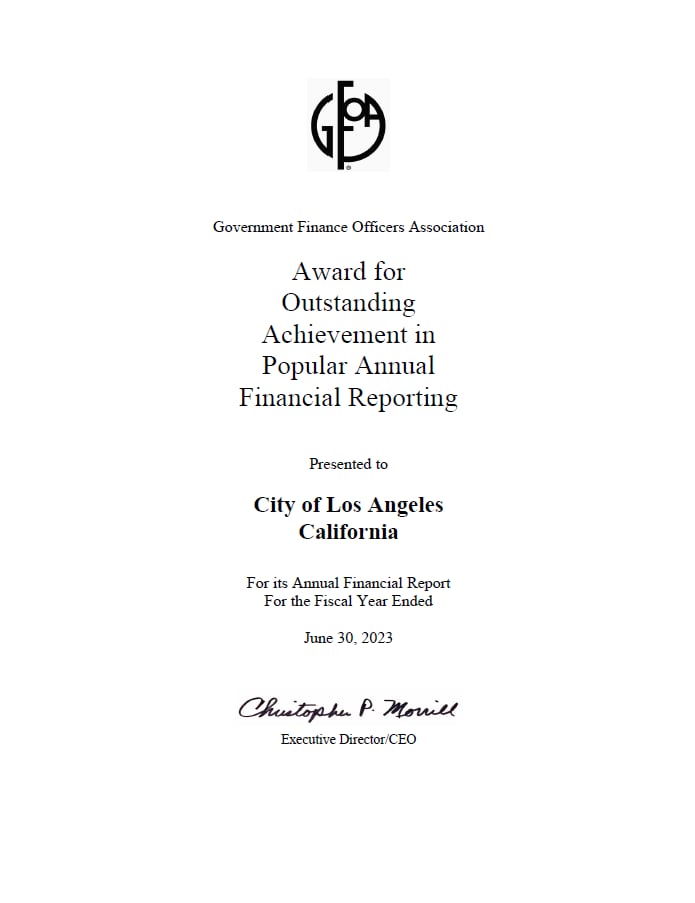LA City Controller Kenneth Mejia releases the Annual Comprehensive Financial Report (ACFR) each January to provide a complete picture of the City’s finances. This website contains the Popular Annual Financial Report (PAFR), a summary of the ACFR that presents the information in a more accessible format, along with charts and graphs measuring how the City serves residents.
A Message from City Controller Kenneth Mejia
Honorable Mayor Karen Bass
Honorable Members of the Council of the City of Los Angeles
Community Members of the City of Los Angeles
 As the Controller for the City of Los Angeles, our Office has the Charter responsibility to prepare and publish the City’s Annual Comprehensive Financial Report (ACFR) of the City for the fiscal year ended June 30, 2024. As we are all painfully aware, revenue shortfalls, liability payouts, and departmental over-expenditures caused the City to end the year in deficit, requiring drawing down nearly half the City’s General Fund Reserves.
As the Controller for the City of Los Angeles, our Office has the Charter responsibility to prepare and publish the City’s Annual Comprehensive Financial Report (ACFR) of the City for the fiscal year ended June 30, 2024. As we are all painfully aware, revenue shortfalls, liability payouts, and departmental over-expenditures caused the City to end the year in deficit, requiring drawing down nearly half the City’s General Fund Reserves.
As we warned at this time last year, the City is continuing to spend well beyond our actual revenues and adopted budget. The City exceeded various department and non-department adopted budgets triggering austerity measures that adversely impacted most departments and city services. The top areas of spending over budget (when compared on a cash basis) included:
- Liability Claims by $153 million (largest shares include Police at $75.1 million and Miscellaneous at $71.6 million)
- Police by $127 million
- General Services by $105 million
At the opposite end, there was underspending in critical areas related to homelessness, infrastructure, animal services, and basic services to make up for the overspending.
In last year’s letter, we predicted
deficits for years to come (that) will force wrenching choices that threaten the vital services Angelenos rely on. This is not the result of a sudden economic downturn, but the culmination of years of short-term budget balancing at the cost of long-term fiscal sustainability.
Short-term budget balancing resulted in the elimination of 1700 then-vacant positions, which included a majority of positions that weren’t vacant for very long. As the year has progressed, the service impacts of those cuts are hitting as departments scramble with severely diminished capacities to address undiminished (and even growing) needs.
Given the devastating damage and disruptions from the firestorm disaster, the fiscal stress could not come at a worse time. We’ve gone from record levels of General Fund reserves 18 months ago to the brink of needing to officially declare a “fiscal emergency.” The full scope is just emerging for disaster response expenses; revenue loss from property damage and business disruption; and the costs of recovery and rebuilding. This added stress on the budget comes on top of the growing responsibilities for preparing for the Olympic and Paralympic Games in 2028.
In January 2025, three rating agencies, S&P, Fitch, and Kroll, placed the City's ratings on negative watch status, indicating that the City's ratings are under review and that there is meaningful potential for a negative rating change. Additionally, Moody's Ratings revised the outlooks on the City's issuer rating for wastewater revenue bonds rating from stable to negative.
Last year at this time we noted that,
The contract for rank and file police staff ratified last fall will add nearly a billion dollars in additional costs over the next four years, with the likelihood of commensurate increases in compensation for police management. The new five year contracts negotiated with civilian bargaining units will have an even larger budget impact, putting budget projections deeply in the red for the next five years.
Unfortunately, those sober predictions proved accurate last fiscal year – and in the current fiscal year, the underbudgeting for the impacts of those contracts leaves many departments forced for the first time into automatic overspending simply to honor the payroll costs of their existing (and understaffed) workforce who are now working even more overtime to keep up. Similarly, the continued underbudgeting of the soaring costs of legal liability judgments and settlements resulted in $240.4 million last fiscal year and estimated to be $301 million for the current fiscal year.
The 3.0% increase over FY23 in General Fund revenues falls below both average historical growth and the rate of growth in expenditures. While property taxes (which represent 40.2% of General Fund revenue) increased by $136.4 million (5.1%), economy-sensitive revenues declined overall versus prior year:
- The ongoing inflation, higher interest rates, and the impacts of the entertainment industry strike negatively affected local economic activities in FY24, resulting in Sales tax decreasing by $28.2 million (4.0%) and Business tax falling by $35.2 million (4.3%).
- Utility users tax (which comprise gas, electric and communication users’ taxes) revenues posted a decrease of $21.5 million (3.0%) primarily due to a drop in gas users tax receipts, after a return of previously high natural gas prices to normal levels.
- Other tax revenues decreased by $66.2 million or 8.1%. There were reductions in both Franchise Income ($30.1 million) and in Documentary Transfer Tax revenue ($49 million), the latter reflecting the slump in real estate sales. Intergovernmental revenues decreased by $11.1 million due to a reduction in State and Federal grant receipts.
While revenues lagged, General Fund expenditures jumped to $6.8 billion, $841 million or 14.0% increase over FY23, primarily due to the following:
- Salaries and Benefits increased by $343.6 million (11.2%) with increases for sworn and civilian employees from new labor agreements as well as increased sworn overtime for the Police and Fire Departments and large retirement and sick payouts for the Fire Department.
- Liability payouts for legal claims rose by $246.6 million, well beyond the $82 million budgeted.
- Capital outlays increased by $68.2 million, although capital expenditures still fall far short of the unfunded needs for street, sidewalk, street light and other vital infrastructure repair and replacement.
- Contractual services, operating equipment, and supplies rose by $138.8 million (12.6%) due to increased costs for homelessness programs, solid waste activities, fleet maintenance and repair, auto parts and equipment, fuel and energy, human resources management project, and outside legal counsel.
- The combined expenditures for retirement contributions and workers' compensation rose by $31.7 million. Additionally, interest payments for debt service increased by $10.7 million, primarily due to higher interest payments for Tax and Revenue Anticipation Notes (TRAN) borrowing that has been used to earn a discount on the City’s pension payments.
The late Dr. Herbert Stein, who chaired the President’s Council of Economic Advisors, wrote,
Things that can’t go on forever, don’t.
Given the grim fiscal prospects for the years ahead, it is time for fundamental change to the City’s unsustainable budgetary practices.
We continue to advocate for the Mayor and Council to develop a strategic five-year plan to fix our City’s finances. Without a long-term approach to putting our fiscal house in order, short-term decisions will doom Los Angeles to an inexorable decline in public services, undermining our quality of life and the economic prospects of our residents.
I strongly commend the Mayor’s capital infrastructure vision outlined in her Executive Directive No. 9 which lays out a comprehensive approach to
making our neighborhoods more resilient and equitable by revitalizing our streets and tackling years of deferred maintenance and underinvestment in our most vulnerable communities.
In that spirit, we have advocated for a transition to a two-year budget cycle that would save enormous staff time, give greater opportunity for meaningful community participation and allow for a more systematic approach to the City’s Finances.
Department heads also need greater flexibility in allocating shrinking resources. They have the responsibility for delivering quality services yet lack the authority to direct hiring and spending within their budgets to best deliver those results.
The City also needs greater transparency and accountability in its budgeting. Unlike most cities, LA segregates pension and benefit costs from department budgets, obscuring the true total cost of personnel. Similarly, LA could learn from cities that have mechanisms for rewarding departments that hold down liability costs and/or penalize those which fail to address preventable liability claims.
Our Office is eager to collaborate with the Mayor, Council and greater community to reform the City’s budgeting process and priorities. This must be a long-term commitment because the problems are long-standing and will require a phased approach to solving. Budget reform and more accountable stewardship of the public’s resources are vital to minimize abrupt service cuts (which disproportionately hurt our most vulnerable).
Finally, I would like to acknowledge the professional and dedicated staff of the Financial Analysis and Reporting Division of the Controller’s Office for the preparation of this report. I would also like to express my appreciation to all those in our Office and citywide who made contributions to the report. At a time of staff shortages and resource constraints, their work is deeply valued and respected.
Should you have questions or require additional information, please contact my Director of Financial Analysis and Reporting, Wally Oyewole at
rahoof.oyewole@lacity.org.
Respectfully submitted,

 Kenneth Mejia
Kenneth Mejia
Los Angeles City Controller

According to the U.S. Bureau of Economic Analysis, Los Angeles-Long Beach-Anaheim, CA (MSA), with a Gross Domestic Product of $1.295 trillion in 2023, is the second- ranked metropolitan area in the United States. The City and its surrounding metropolitan region feature incredible diversity in both population and the economy. Tourism and hospitality, professional and business services, international trade and education, entertainment production, sports, and wholesale trade and logistics all contribute significantly to local employment.
The Port of Los Angeles handles the largest volume of containerized cargo of all U.S. ports and ranks as number one in cargo value for U.S. waterborne foreign traffic. According to ACI World’s 2023 Airport Traffic Report, in the calendar year 2023, Los Angeles International Airport (LAX) ranked as the eighth busiest airport in the world in terms of total passengers and the ninth busiest airport in the world in terms of total cargo. The Los Angeles MSA experienced strong economic growth in 2023, with an increase in economic output of 4.8%, as measured by Gross Domestic Product.
The fiscal year 2025 General Fund Budget assumes the City would see solid revenue growth while continuing to make historic investments to reduce homelessness and improve public safety. While the economic activities and General Fund revenues continue to remain stable during the first half of fiscal year 2025, there remain several factors that could affect future economic outlook and the economically-sensitive revenue sources.
A critical part of Los Angeles' economy depends on the entertainment industry. The filming activities reportedly hit a new low in 2024, driven by studio cost cutting and the relocation of production to cheaper locales, including U.K. and Central Europe. Some executives attributed the decline in production to increased cost of labor from the 2023 strike, a contention rejected by union leaders. An undisputed factor is California’s inability to compete with tax incentives offered by other states and countries, a situation that Governor Newsom is now trying to address. Businesses that rely on the entertainment economy are rallying behind the Governor’s proposal to increase annual film and TV tax credit allocation from $330 million to $750 million. This should help keep more production in Los Angeles. It is unclear, however, how much of the decline can be reversed with the new tax incentive policy.
Property taxes are the biggest source of revenue for the General Fund and higher mortgage interest rates continue to affect affordability and real estate sales volume in Los Angeles and surrounding areas. However, the California Association of Realtors (C.A.R.) recently released its 2025 housing and economic forecast, predicting a stable economy and lower interest rate environment that would stimulate sales and price appreciation in 2025. Any improvement in housing sales and prices should boost transfer tax revenues to the General Fund.
Finally, at the time of this report, the City is dealing with a major fire disaster in Pacific Palisades and other communities, the magnitude of which the City has never seen. Several widespread fires burned thousands of acres, devastating many communities and families. The fires have reportedly burned thousands of homes and businesses, with many lives lost. While the firefighters and first responders are still working around the clock to put out fires in many areas, the disaster so far has been described as one of the worst disasters in United States’ history, with preliminary property loss estimates ranging in the billions. The impacted Angelenos face a long road ahead as they try to rebuild their lives. Although the scale of the impact is still being assessed at the time of this report, the loss of this magnitude is bound to significantly affect the local economy and revenues to the City.
Because of all these factors, the City is likely to be facing fiscal challenges for a foreseeable future. It is therefore incumbent on City policymakers to plan accordingly, rethink priorities and implement General Fund expenditure reduction measures, should in case the projected growth in General Fund revenue fails to materialize. The City’s initial fire damage estimate submitted to FEMA shows a total of $358.0 million in costs related to emergency response, infrastructure/structural damages and debris removal estimated through January 10, 2025.

 As the Controller for the City of Los Angeles, our Office has the Charter responsibility to prepare and publish the City’s Annual Comprehensive Financial Report (ACFR) of the City for the fiscal year ended June 30, 2024. As we are all painfully aware, revenue shortfalls, liability payouts, and departmental over-expenditures caused the City to end the year in deficit, requiring drawing down nearly half the City’s General Fund Reserves.
As the Controller for the City of Los Angeles, our Office has the Charter responsibility to prepare and publish the City’s Annual Comprehensive Financial Report (ACFR) of the City for the fiscal year ended June 30, 2024. As we are all painfully aware, revenue shortfalls, liability payouts, and departmental over-expenditures caused the City to end the year in deficit, requiring drawing down nearly half the City’s General Fund Reserves.
 Kenneth Mejia
Kenneth Mejia

